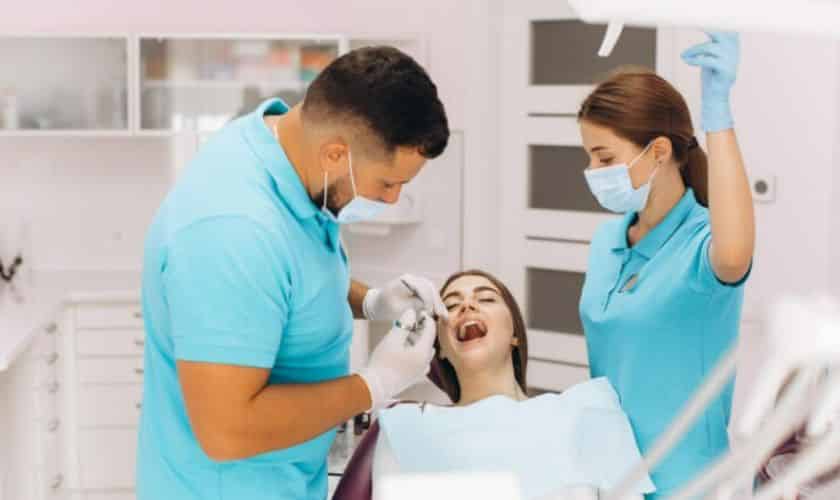Welcome to “Unlocking the Path to Peace: The Emergency Dentist’s Guide.” Dental emergencies can be distressing, causing pain and anxiety. However, there is hope, and this guide is your key to finding tranquility amidst the chaos. Whether it’s a sudden toothache, a broken tooth, or any other urgent dental issue, the expertise of an emergency dentist can save the day. In this comprehensive guide, we will navigate through the realm of dental emergencies, unveiling essential insights, tips, and strategies to help you find peace. Explore the invaluable knowledge that emergency dentists possess and embark on a journey towards dental serenity. Say goodbye to pain and embrace the path to peace with the help of this enlightening guide.

What Are Some Typical Dental Urgencies
The following conditions constitute a Dental Emergency:
- Severe toothaches: Intense, persistent tooth pain often caused by tooth decay or infection.
- Dental abscesses: Pockets of pus caused by bacterial infection, leading to throbbing pain, swelling, and fever.
- Broken or chipped teeth: Fractured or damaged teeth resulting from accidents, injuries, or biting on hard objects.
- Knocked-out or displaced teeth: Teeth that have been completely knocked out or pushed out of alignment due to trauma.
- Lost dental fillings or crowns: Dislodged or lost dental restorations, exposing the vulnerable tooth structure.
- Soft tissue injuries and oral bleeding: Cuts, lacerations, or trauma to the lips, tongue, or gums, resulting in bleeding and discomfort.
The Expertise Of An Emergency Dentist
Emergency dentists possess specialized expertise in handling urgent dental situations. Here are some key aspects of their expertise:
1. Quick assessment: Emergency dentists are skilled at quickly assessing the nature and severity of dental emergencies, allowing them to formulate the most appropriate treatment plan.
2. Pain management: They have the knowledge and techniques to provide effective pain relief, whether through local anesthesia, sedation, or other suitable methods, ensuring patients are comfortable during the emergency procedure.
3. Dental restoration: Emergency dentists are proficient in performing immediate dental repairs, such as temporary fillings, dental bonding, or repositioning of displaced teeth, in stabilizing the situation until further treatment can occur.
4. Infection control: They are trained in managing and preventing infections, including prescribing antibiotics if necessary, to address dental infections and minimize the risk of complications.
5. Collaborative approach: Emergency dentists work closely with other dental specialists or healthcare professionals as needed, ensuring comprehensive care for the patient’s overall oral health and well-being.
Swift Actions to Undertake During a Dental Emergency
During a dental emergency, taking immediate steps can help alleviate pain and prevent further damage. Here are some important home remedies to ease the pain before you reach a dentist:
1. Stay calm: It’s essential to stay calm and collected to think clearly and make the right decisions during a dental emergency.
2. Assess the situation: Evaluate the severity of the emergency. If there is severe bleeding, a broken tooth, or significant pain, it may require immediate attention from an emergency dentist.
3. Rinse with warm water: If a foreign object is lodged between teeth or in the mouth, gently remove it with warm water. Avoid using any sharp or pointed objects to dislodge the object.
4. Control bleeding: Apply gentle pressure with a clean cloth or sterile gauze to control bleeding. If bleeding persists or is excessive, seek immediate dental care.
5. Manage pain: Over-the-counter pain relievers can help manage dental pain temporarily. Avoid placing aspirin directly on the affected area, which may cause further irritation.
6. Protect a knocked-out tooth: If it has been knocked out, carefully handle it by the crown (top) and rinse it gently with water. Try to reinsert it into the socket or place it in a container of milk or saliva to keep it moist.
7. Seek professional help: Contact an emergency dentist or dental clinic to explain the situation and receive guidance on the next steps. They can provide immediate advice or schedule an emergency appointment.
Emergency Dental Care Process
The emergency dental care process involves the following steps:
1. Evaluation: The emergency dentist will assess the patient’s condition, examining the affected area and reviewing the patient’s medical history.
2. Diagnosis: The dentist will diagnose the dental emergency, determining the underlying issue causing the pain or discomfort.
3. Immediate pain relief: The dentist will provide immediate pain relief measures, such as administering local anesthesia or pain medications.
4. Treatment planning: After assessing the situation, the dentist will develop a treatment plan to address the dental emergency effectively.
5. Emergency treatment: The dentist will perform the necessary procedures to treat the dental emergency, including tooth extraction, filling cavities, repairing broken teeth, or treating infections.
6. Post-treatment instructions: The dentist will provide post-treatment instructions to promote healing and prevent complications. It may include guidelines for oral hygiene, dietary restrictions, and follow-up appointments.
7. Follow-up care: Depending on the nature of the dental emergency, the patient may require additional follow-up appointments for further treatment or monitoring.
Preventive Measures And Oral Health Education
1. Regular dental check-ups: Visiting the dentist for routine check-ups allows for early detection and prevention of dental issues.
2. Proper oral hygiene: Brushing teeth twice daily, flossing daily, and using mouthwash help maintain good oral health and prevent dental problems.
3. Balanced diet: Eating a balanced diet rich in nutrients and low in sugary foods and drinks promotes healthy teeth and gums.
4. Protective gear during physical activities: Wearing mouthguards or other protective gear during sports or physical activities can prevent dental injuries.
5. Oral health education: Learning about proper oral hygiene practices and receiving education on oral health from dental professionals helps individuals make informed decisions and better care of their teeth and gums.
Tips to Find An Emergency Dentist
1. Research and recommendations: Seek recommendations from friends, family, or healthcare professionals for reputable emergency dentists in your area. Conduct online research to gather more information.
2. 24/7 availability: Look for emergency dentists who offer round-the-clock availability, including evenings, weekends, and holidays, to ensure you can receive immediate care when needed.
3. Emergency contact information: Save the contact information of emergency dental clinics or dentists in your phone or keep it easily accessible, so you can quickly reach out during a dental emergency.
4. Insurance coverage: Check if the emergency dentist accepts your dental insurance or offers flexible payment options to make the treatment more affordable.
5. Credentials and experience: Look for emergency dentists who are experienced, licensed, and certified in emergency dental care. Consider their reputation, reviews, and testimonials to gauge the quality of their services.
Source : American Dental Association (ADA)
In conclusion, “Unlocking the Path to Peace: The Emergency Dentist’s Guide” empowers you with the knowledge and resources to navigate dental emergencies with confidence. By understanding the expertise and guidance of emergency dentists, you can face dental distress head-on and find solace in their capable hands. Embrace this guide as your compass, unlocking a path to peace and ensuring your dental well-being in times of urgency. Remember, peace awaits, and emergency dentistry is there to pull you up from agony!




